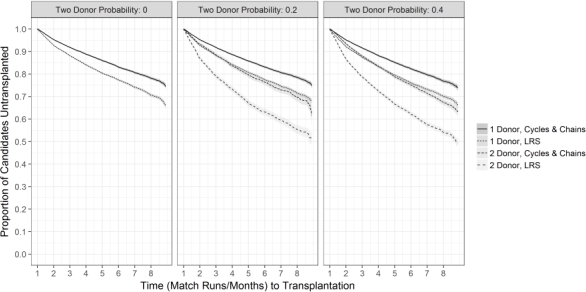Gains from Joining Kidney Paired Donation with Several Incompatible Donors
University of Michigan, Ann Arbor, MI.
Meeting: 2018 American Transplant Congress
Abstract number: A161
Keywords: Allocation, Donation, Kidney transplantation
Session Information
Session Name: Poster Session A: Kidney Paired Exchange
Session Type: Poster Session
Date: Saturday, June 2, 2018
Session Time: 5:30pm-7:30pm
 Presentation Time: 5:30pm-7:30pm
Presentation Time: 5:30pm-7:30pm
Location: Hall 4EF
In kidney paired donation (KPD), a transplant candidate with an incompatible donor joins a pool of similar pairs in an effort to find new transplant opportunities through the exchange of donors. The aim in KPD is typically to maximize the number of transplants through closed cycles of donor exchanges among the pairs, or transplant chains originating from non-directed donors. Adjustments can also be made to account for factors such as candidate degree of sensitivity or waiting time. We have previously examined the benefits of accounting for the possibility that selected exchanges cannot proceed to actual transplantation (e.g. due to withdrawal, reversal of presumed compatibility, etc.), as well as preparing fallback options in the case such events (Li et al, SIBS 2014; Bray et al, AJT 2015).
In practice, a candidate may have two or more incompatible donors willing to join KPD, which introduces transplant opportunities and additional fallback options. We have two aims: (i) to extend previous KPD optimization algorithms to properly account for candidates with several incompatible donors; and (ii) to evaluate the benefits to the candidate and the overall pool of multiple donor-candidate pairs, in terms of number of achieved transplants and waiting time for candidates.
Figure 1 displays Kaplan-Meier curves from previous simulations, showing the proportion of untransplanted candidates remaining in the pool over time for evolving KPD pools consisting of 0%, 20% and 40% two-donor candidates under different optimization settings: selecting the best set of cycles and chains outright at each match run (“Cycles and Chains”) versus methods based on selecting the best set of locally relevant subsets of transplants which exploits the selection and use of fallback options. Locally relevant subsets are defined and studied in Wang et al. (ORHC, submitted 2017) and Bray et al. (SIBS, submitted 2017).
CITATION INFORMATION: Bray M., Wang W., Song P., Kalbfleisch J. Gains from Joining Kidney Paired Donation with Several Incompatible Donors Am J Transplant. 2017;17 (suppl 3).
To cite this abstract in AMA style:
Bray M, Wang W, Song P, Kalbfleisch J. Gains from Joining Kidney Paired Donation with Several Incompatible Donors [abstract]. https://atcmeetingabstracts.com/abstract/gains-from-joining-kidney-paired-donation-with-several-incompatible-donors/. Accessed December 25, 2025.« Back to 2018 American Transplant Congress

